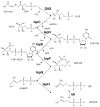The Mycobacterium tuberculosis MEP (2C-methyl-d-erythritol 4-phosphate) pathway as a new drug target
- PMID: 18793870
- PMCID: PMC2646905
- DOI: 10.1016/j.tube.2008.07.004
The Mycobacterium tuberculosis MEP (2C-methyl-d-erythritol 4-phosphate) pathway as a new drug target
Abstract
Tuberculosis (TB) is still a major public health problem, compounded by the human immunodeficiency virus (HIV)-TB co-infection and recent emergence of multidrug-resistant (MDR) and extensively drug resistant (XDR)-TB. Novel anti-TB drugs are urgently required. In this context, the 2C-methyl-d-erythritol 4-phosphate (MEP) pathway of Mycobacterium tuberculosis has drawn attention; it is one of several pathways vital for M. tuberculosis viability and the human host lacks homologous enzymes. Thus, the MEP pathway promises bacterium-specific drug targets and the potential for identification of lead compounds unencumbered by target-based toxicity. Indeed, fosmidomycin is now known to inhibit the second step in the MEP pathway. This review describes the cardinal features of the main enzymes of the MEP pathway in M. tuberculosis and how these can be manipulated in high throughput screening campaigns in the search for new anti-infectives against TB.
Figures



References
-
- WHO report 2007. Geneva: World Health Organization (WHO/HTM/TB/2007376); 2007. Global tuberculosis control: surveillance, planning, financing.
-
- Sutherland I. Recent studies in the epidemiology of tuberculosis, based on the risk of being infected with tubercle bacilli. Advances in tuberculosis research Fortschritte der Tuberkuloseforschung. 1976;19:1–63. - PubMed
-
- Selwyn PA, Hartel D, Lewis VA, Schoenbaum EE, Vermund SH, Klein RS, Walker AT, Friedland GH. A prospective study of the risk of tuberculosis among intravenous drug users with human immunodeficiency virus infection. The New England journal of medicine. 1989;320:545–50. - PubMed
Publication types
MeSH terms
Substances
Grants and funding
LinkOut - more resources
Full Text Sources
Medical

